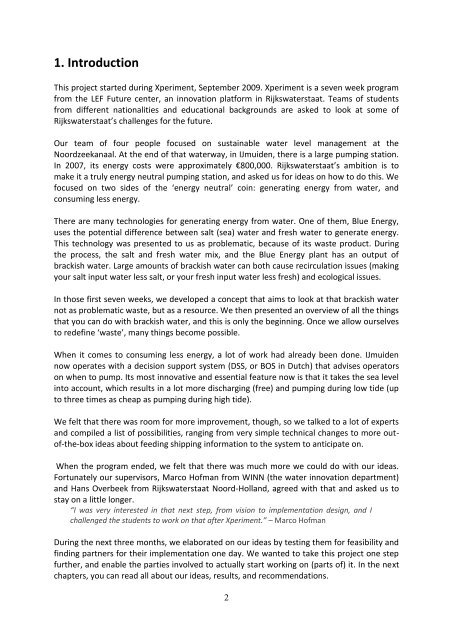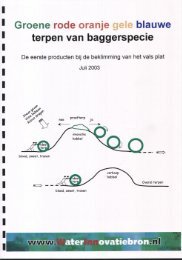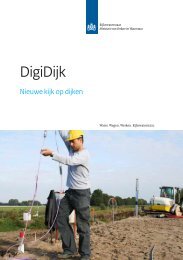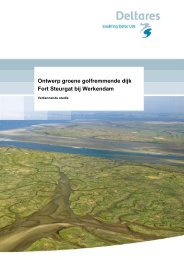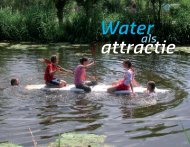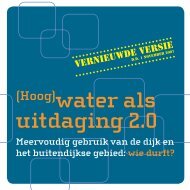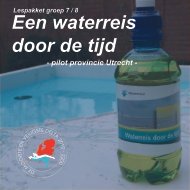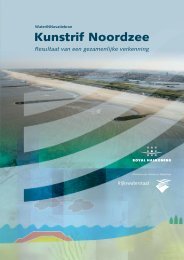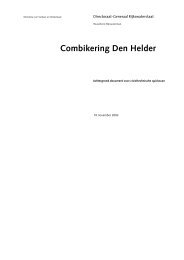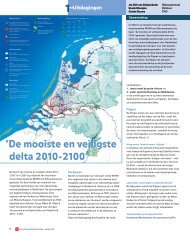Creating opportunities to adapt to climate change through innovative ...
Creating opportunities to adapt to climate change through innovative ...
Creating opportunities to adapt to climate change through innovative ...
You also want an ePaper? Increase the reach of your titles
YUMPU automatically turns print PDFs into web optimized ePapers that Google loves.
1. IntroductionThis project started during Xperiment, September 2009. Xperiment is a seven week programfrom the LEF Future center, an innovation platform in Rijkswaterstaat. Teams of studentsfrom different nationalities and educational backgrounds are asked <strong>to</strong> look at some ofRijkswaterstaat’s challenges for the future.Our team of four people focused on sustainable water level management at theNoordzeekanaal. At the end of that waterway, in IJmuiden, there is a large pumping station.In 2007, its energy costs were approximately €800,000. Rijkswaterstaat’s ambition is <strong>to</strong>make it a truly energy neutral pumping station, and asked us for ideas on how <strong>to</strong> do this. Wefocused on two sides of the ‘energy neutral’ coin: generating energy from water, andconsuming less energy.There are many technologies for generating energy from water. One of them, Blue Energy,uses the potential difference between salt (sea) water and fresh water <strong>to</strong> generate energy.This technology was presented <strong>to</strong> us as problematic, because of its waste product. Duringthe process, the salt and fresh water mix, and the Blue Energy plant has an output ofbrackish water. Large amounts of brackish water can both cause recirculation issues (makingyour salt input water less salt, or your fresh input water less fresh) and ecological issues.In those first seven weeks, we developed a concept that aims <strong>to</strong> look at that brackish waternot as problematic waste, but as a resource. We then presented an overview of all the thingsthat you can do with brackish water, and this is only the beginning. Once we allow ourselves<strong>to</strong> redefine ‘waste’, many things become possible.When it comes <strong>to</strong> consuming less energy, a lot of work had already been done. IJmuidennow operates with a decision support system (DSS, or BOS in Dutch) that advises opera<strong>to</strong>rson when <strong>to</strong> pump. Its most <strong>innovative</strong> and essential feature now is that it takes the sea levelin<strong>to</strong> account, which results in a lot more discharging (free) and pumping during low tide (up<strong>to</strong> three times as cheap as pumping during high tide).We felt that there was room for more improvement, though, so we talked <strong>to</strong> a lot of expertsand compiled a list of possibilities, ranging from very simple technical <strong>change</strong>s <strong>to</strong> more ou<strong>to</strong>f-the-boxideas about feeding shipping information <strong>to</strong> the system <strong>to</strong> anticipate on.When the program ended, we felt that there was much more we could do with our ideas.Fortunately our supervisors, Marco Hofman from WINN (the water innovation department)and Hans Overbeek from Rijkswaterstaat Noord-Holland, agreed with that and asked us <strong>to</strong>stay on a little longer.“I was very interested in that next step, from vision <strong>to</strong> implementation design, and Ichallenged the students <strong>to</strong> work on that after Xperiment.” – Marco HofmanDuring the next three months, we elaborated on our ideas by testing them for feasibility andfinding partners for their implementation one day. We wanted <strong>to</strong> take this project one stepfurther, and enable the parties involved <strong>to</strong> actually start working on (parts of) it. In the nextchapters, you can read all about our ideas, results, and recommendations.2


